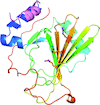issue contents
December 2020 issue

Cover illustration: The hypothetical periplasmic protein PA1624 from the opportunistic pathogen Pseudomonas aeruginosa folds into a unique two-domain structure [Feiler et al. (2020), Acta Cryst. F76, 609-615]. Since PA1624 is only present in this important human pathogen, its unique structure and periplasmic location render it a potential drug target. These results may open new avenues for the discovery and design of antibacterial drugs.
research communications
 access
access access
access access
accessISDSB
 access
accessaddenda and errata



 journal menu
journal menu




















![[publBio]](/logos/publbio.gif)





